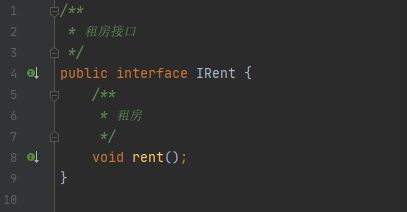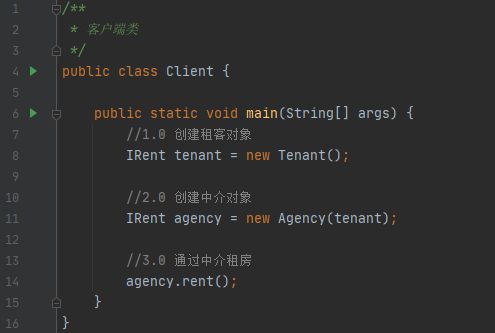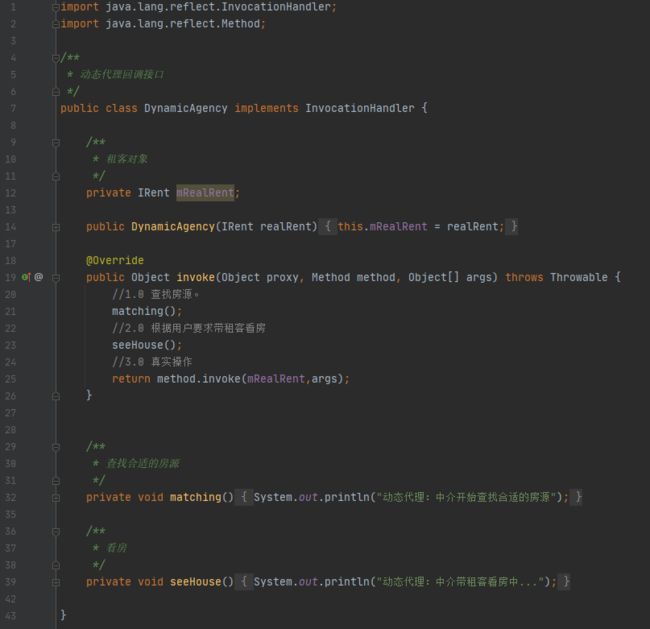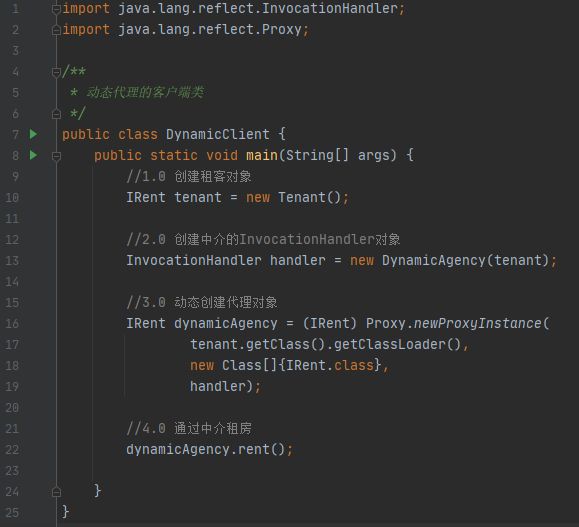深入理解Java中的代理模式
#一:代理模式
一种设计模式,提供了一种间接对目标进行访问操作的方式。
#二:优点
调用者只需要把需求告诉代理者,内部做的其他操作,调用者可以不用关心。
#三:相关对象
1.抽象接口(IRent):
声明的要做的事情。这里我们以租房为例。
2.真实角色(Tenant):
实现抽象接口,是真正事情的执行者。也叫被代理角色。
3.代理角色(Agency):
也叫做代理类,对真实角色进行代理和包装,在真实角色处理的事情前后,加入一些其他操作。
从UML图中,我们可以看到。
我们有一个租房的操作(IRent)。
**租客(Tenant)和中介(Agency)**分别实现了IRent接口,并且中介持有租客对象的引用。
#五:Java中的代理模式分类
在Java中,代理模式主要分为两类,静态代理和动态代理。
1.静态代理
在程序编译前,真实角色和代理角色(.class)文件就已经被创建好了。
2.动态代理
代理角色在程序运行期间,由JVM动态生成。代理角色和被代理角色的关系也是在运行时才被确定下来的。
接下来,我们来看一下代码中这两种的区别。
从上述图中,我们可以看出,中介在租客租房前做了一系列操作。调用者根本不需要关心其内部是如何实现的,只需要把租客对象创建好交给中介即可。
下面我们来看一下运行结果。

##动态代理
动态代理与静态代理在概念上是一样的,区别在于动态代理的代理类是在JVM运行期间动态创建。
讲到动态代理,我们先介绍几个相关的类和接口。
###1.InvocationHandler
系统定义的一个接口模板(我们看成普通的接口即可)
接口中仅仅定义了一个普通的invoke方法,方法体如下:

###2.Proxy
定义在java.lang.reflect包下,提供了newProxyInstance方法给我们动态创建代理类。接口定义如下:

该方法需要传入3个参数。
1.ClassLoader loader 为类加载器,默认我们传入调用者的类加载器即可。
2.Class[] interfaces为接口数组。
3.InvocationHandler h为实现了该接口的回调类,后续真实对象的方法的调用,都会回调到该接口的invoke方法中。
下面我们看看在代码中的具体实现。
1.**租房接口(IRent)和租客类(Tenant)**的定义都跟静态代理的一致。
由上述可知,我们创建了租客对象(tenant),并将租客对象委托给实现了InvocationHandler接口的对象(handler),最后通过Proxy的newProxyInstance方法创建出中介代理对象(dynamicAgency),最后还是通过中介对象去完成租房的操作。我们来看一下程序执行的结果。

从执行结果也可以得出,动态代理和静态代理挺类似的,唯一的区别仅是代理对象的创建方式。
下面我们来从源码的角度来分析动态代理是如何实现的。
#七:动态代理源码分析
关于动态代理我们有几个疑问。
1.动态代理产生的对象到底是什么?
2.是如何产生该对象的?
3.该对象是如何代理我们的方法的?
带着上面的问题,我们从源码中去寻找答案。
首先第1个问题,动态代理产生的对象到底是什么?这一个问题,我们可以通过打印该对象的类型(Class)来查看。
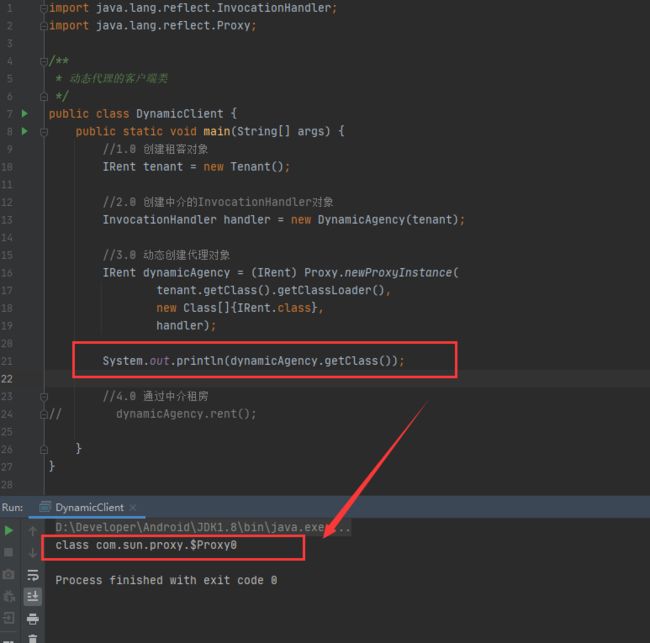
通过打印log可以看出,系统为我们产生了一个类名为 com.sun.proxy.$Proxy0 的类。
那么这个Class是如何产生的呢?也就是第2个问题,系统是如何帮我们动态产生该对象的?
我们跟进去 Proxy 类的 newProxyInstance 方法。(这里看的JDK1.8版本的源码)
public static Object newProxyInstance(ClassLoader loader,
Class[] interfaces,
InvocationHandler h)
throws IllegalArgumentException
{
Objects.requireNonNull(h);
final Class[] intfs = interfaces.clone();
final SecurityManager sm = System.getSecurityManager();
if (sm != null) {
checkProxyAccess(Reflection.getCallerClass(), loader, intfs);
}
/*
* Look up or generate the designated proxy class.
*/
Class cl = getProxyClass0(loader, intfs);
/*
* Invoke its constructor with the designated invocation handler.
*/
try {
if (sm != null) {
checkNewProxyPermission(Reflection.getCallerClass(), cl);
}
final Constructor cons = cl.getConstructor(constructorParams);
final InvocationHandler ih = h;
if (!Modifier.isPublic(cl.getModifiers())) {
AccessController.doPrivileged(new PrivilegedAction() {
public Void run() {
cons.setAccessible(true);
return null;
}
});
}
return cons.newInstance(new Object[]{h});
} catch (IllegalAccessException|InstantiationException e) {
throw new InternalError(e.toString(), e);
} catch (InvocationTargetException e) {
Throwable t = e.getCause();
if (t instanceof RuntimeException) {
throw (RuntimeException) t;
} else {
throw new InternalError(t.toString(), t);
}
} catch (NoSuchMethodException e) {
throw new InternalError(e.toString(), e);
}
}
newProxyInstance方法的代码并不是很多。
1.做一些安全方面的校验。
2.通过getProxyClass0方法,获得一个类型对象(Class)。
3.通过该类型对象的getConstructor获取该类型的构造函数Constructor对象。
该构造方法传入的参数为constructorParams。那这个constructorParams到底是什么呢?
private static final Class[] constructorParams = { InvocationHandler.class };
参数是一个Class类型数组,里面仅有一个InvocationHandler类型。这个类型就是动态代理要求实现的对调接口类型。
4.最后通过cons.newInstance(new Object[]{h});反射的方式创建出我们的代理对象,注意这里把我们自己创建的InvocationHandler对象传入到了动态创建的对象中。
所以动态代理其实系统是通过该代理对象的Class,反射创建出来的对象。接下来,我们只需要找到是如何产生该Class文件即可解开所有疑问。
我们跟到getProxyClass0方法
private static Class getProxyClass0(ClassLoader loader,
Class... interfaces) {
if (interfaces.length > 65535) {
throw new IllegalArgumentException("interface limit exceeded");
}
// If the proxy class defined by the given loader implementing
// the given interfaces exists, this will simply return the cached copy;
// otherwise, it will create the proxy class via the ProxyClassFactory
return proxyClassCache.get(loader, interfaces);
}
该方法首先会检查我们定义的接口的方法数量,一般我们使用也不会超过该数量。
接着会调用proxyClassCache的get方法,并传入ClassLoadner和我们定义的Interfaces接口数组。
proxyClassCache 是 WeakCache类型的。
private static final WeakCache[], Class>
proxyClassCache = new WeakCache<>(new KeyFactory(), new ProxyClassFactory());
该对象的get方法,代码并不多,我们可以跟进去看看。
public V get(K key, P parameter) {
Objects.requireNonNull(parameter);
expungeStaleEntries();
Object cacheKey = CacheKey.valueOf(key, refQueue);
// lazily install the 2nd level valuesMap for the particular cacheKey
ConcurrentMap> valuesMap = map.get(cacheKey);
if (valuesMap == null) {
ConcurrentMap> oldValuesMap
= map.putIfAbsent(cacheKey,
valuesMap = new ConcurrentHashMap<>());
if (oldValuesMap != null) {
valuesMap = oldValuesMap;
}
}
// create subKey and retrieve the possible Supplier stored by that
// subKey from valuesMap
Object subKey = Objects.requireNonNull(subKeyFactory.apply(key, parameter));
Supplier supplier = valuesMap.get(subKey);
Factory factory = null;
while (true) {
if (supplier != null) {
// supplier might be a Factory or a CacheValue instance
V value = supplier.get();
if (value != null) {
return value;
}
}
// else no supplier in cache
// or a supplier that returned null (could be a cleared CacheValue
// or a Factory that wasn't successful in installing the CacheValue)
// lazily construct a Factory
if (factory == null) {
factory = new Factory(key, parameter, subKey, valuesMap);
}
if (supplier == null) {
supplier = valuesMap.putIfAbsent(subKey, factory);
if (supplier == null) {
// successfully installed Factory
supplier = factory;
}
// else retry with winning supplier
} else {
if (valuesMap.replace(subKey, supplier, factory)) {
// successfully replaced
// cleared CacheEntry / unsuccessful Factory
// with our Factory
supplier = factory;
} else {
// retry with current supplier
supplier = valuesMap.get(subKey);
}
}
}
}
1.首先会根据ClassLoader和Interface数组去缓存中查找,如果查找的到直接返回缓存结果。看一下关键代码。
Object cacheKey = CacheKey.valueOf(key, refQueue);
ConcurrentMap> valuesMap = map.get(cacheKey);
Object subKey = Objects.requireNonNull(subKeyFactory.apply(key, parameter));
Supplier supplier = valuesMap.get(subKey);
if (supplier != null) {
// supplier might be a Factory or a CacheValue instance
V value = supplier.get();
if (value != null) {
return value;
}
}
第一次一定是拿不到缓存的,所以我们先跳过这一部分。
2.在while循环中,会去创建Factory工厂对象。并将其赋值给supplier变量。
if (factory == null) {
factory = new Factory(key, parameter, subKey, valuesMap);
}
if (supplier == null) {
supplier = valuesMap.putIfAbsent(subKey, factory);
if (supplier == null) {
// successfully installed Factory
supplier = factory;
}
// else retry with winning supplier
} else {
if (valuesMap.replace(subKey, supplier, factory)) {
// successfully replaced
/ cleared CacheEntry / unsuccessful Factory
// with our Factory
supplier = factory;
} else {
// retry with current supplier
supplier = valuesMap.get(subKey);
}
}
3.所以现在的关键点就是Factor,该工厂是如何创建对象的,我们继续看下去。
Factory为WeakCache的一个内部类,并实现了Supplier接口。
Supplier是JDK1.8出的一个函数式接口,其定义很简单,提供一个get方法用于创建对象。
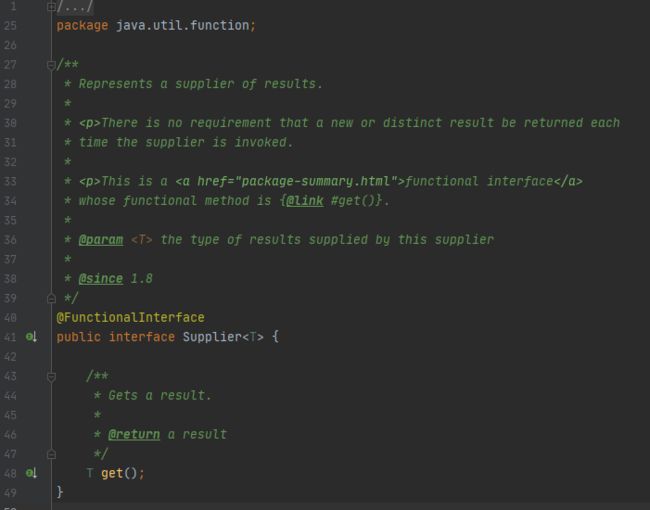
private final class Factory implements Supplier {
private final K key;
private final P parameter;
private final Object subKey;
private final ConcurrentMap> valuesMap;
Factory(K key, P parameter, Object subKey,
ConcurrentMap> valuesMap) {
this.key = key;
this.parameter = parameter;
this.subKey = subKey;
this.valuesMap = valuesMap;
}
@Override
public synchronized V get() { // serialize access
// re-check
Supplier supplier = valuesMap.get(subKey);
if (supplier != this) {
// something changed while we were waiting:
// might be that we were replaced by a CacheValue
// or were removed because of failure ->
// return null to signal WeakCache.get() to retry
// the loop
return null;
}
// else still us (supplier == this)
// create new value
V value = null;
try {
value = Objects.requireNonNull(valueFactory.apply(key, parameter));
} finally {
if (value == null) { // remove us on failure
valuesMap.remove(subKey, this);
}
}
// the only path to reach here is with non-null value
assert value != null;
// wrap value with CacheValue (WeakReference)
CacheValue cacheValue = new CacheValue<>(value);
// put into reverseMap
reverseMap.put(cacheValue, Boolean.TRUE);
// try replacing us with CacheValue (this should always succeed)
if (!valuesMap.replace(subKey, this, cacheValue)) {
throw new AssertionError("Should not reach here");
}
// successfully replaced us with new CacheValue -> return the value
// wrapped by it
return value;
}
}
1.Factory 的 get方法会交给**valueFactory.apply(key, parameter)**方法创建,这里的valueFactory是一个BiFunction接口。
private final BiFunction valueFactory;
该接口定义如下
@FunctionalInterface
public interface BiFunction {
/**
* Applies this function to the given arguments.
*
* @param t the first function argument
* @param u the second function argument
* @return the function result
*/
R apply(T t, U u);
/**
* Returns a composed function that first applies this function to
* its input, and then applies the {@code after} function to the result.
* If evaluation of either function throws an exception, it is relayed to
* the caller of the composed function.
*
* @param the type of output of the {@code after} function, and of the
* composed function
* @param after the function to apply after this function is applied
* @return a composed function that first applies this function and then
* applies the {@code after} function
* @throws NullPointerException if after is null
*/
default BiFunction andThen(Function after) {
Objects.requireNonNull(after);
return (T t, U u) -> after.apply(apply(t, u));
}
}
该变量的具体实现类,在Proxy创建WeakCache的时候的注入了。
public WeakCache(BiFunction subKeyFactory,
BiFunction valueFactory) {
this.subKeyFactory = Objects.requireNonNull(subKeyFactory);
this.valueFactory = Objects.requireNonNull(valueFactory);
}
private static final WeakCache[], Class>
proxyClassCache = new WeakCache<>(new KeyFactory(), new ProxyClassFactory());
所以WeakCache的具体实现类其实是ProxyClassFactory。
ProxyClassFactory的代码稍微有点长,我们来总结一下大概做哪些事情。
private static final class ProxyClassFactory
implements BiFunction[], Class>
{
// prefix for all proxy class names
private static final String proxyClassNamePrefix = "$Proxy";
// next number to use for generation of unique proxy class names
private static final AtomicLong nextUniqueNumber = new AtomicLong();
@Override
public Class apply(ClassLoader loader, Class[] interfaces) {
Map, Boolean> interfaceSet = new IdentityHashMap<>(interfaces.length);
for (Class intf : interfaces) {
/*
* Verify that the class loader resolves the name of this
* interface to the same Class object.
*/
Class interfaceClass = null;
try {
interfaceClass = Class.forName(intf.getName(), false, loader);
} catch (ClassNotFoundException e) {
}
if (interfaceClass != intf) {
throw new IllegalArgumentException(
intf + " is not visible from class loader");
}
/*
* Verify that the Class object actually represents an
* interface.
*/
if (!interfaceClass.isInterface()) {
throw new IllegalArgumentException(
interfaceClass.getName() + " is not an interface");
}
/*
* Verify that this interface is not a duplicate.
*/
if (interfaceSet.put(interfaceClass, Boolean.TRUE) != null) {
throw new IllegalArgumentException(
"repeated interface: " + interfaceClass.getName());
}
}
String proxyPkg = null; // package to define proxy class in
int accessFlags = Modifier.PUBLIC | Modifier.FINAL;
/*
* Record the package of a non-public proxy interface so that the
* proxy class will be defined in the same package. Verify that
* all non-public proxy interfaces are in the same package.
*/
for (Class intf : interfaces) {
int flags = intf.getModifiers();
if (!Modifier.isPublic(flags)) {
accessFlags = Modifier.FINAL;
String name = intf.getName();
int n = name.lastIndexOf('.');
String pkg = ((n == -1) ? "" : name.substring(0, n + 1));
if (proxyPkg == null) {
proxyPkg = pkg;
} else if (!pkg.equals(proxyPkg)) {
throw new IllegalArgumentException(
"non-public interfaces from different packages");
}
}
}
if (proxyPkg == null) {
// if no non-public proxy interfaces, use com.sun.proxy package
proxyPkg = ReflectUtil.PROXY_PACKAGE + ".";
}
/*
* Choose a name for the proxy class to generate.
*/
long num = nextUniqueNumber.getAndIncrement();
String proxyName = proxyPkg + proxyClassNamePrefix + num;
/*
* Generate the specified proxy class.
*/
byte[] proxyClassFile = ProxyGenerator.generateProxyClass(
proxyName, interfaces, accessFlags);
try {
return defineClass0(loader, proxyName,
proxyClassFile, 0, proxyClassFile.length);
} catch (ClassFormatError e) {
/*
* A ClassFormatError here means that (barring bugs in the
* proxy class generation code) there was some other
* invalid aspect of the arguments supplied to the proxy
* class creation (such as virtual machine limitations
* exceeded).
*/
throw new IllegalArgumentException(e.toString());
}
}
}
1.遍历我们传入的接口数组,将该接口的Class对象加载进内存中,并将加载好的Class对象保存到集合中。
Map, Boolean> interfaceSet = new IdentityHashMap<>(interfaces.length);
for (Class intf : interfaces) {
/*
* Verify that the class loader resolves the name of this
* interface to the same Class object.
*/
Class interfaceClass = null;
try {
interfaceClass = Class.forName(intf.getName(), false, loader);
} catch (ClassNotFoundException e) {
}
if (interfaceClass != intf) {
throw new IllegalArgumentException(
intf + " is not visible from class loader");
}
/*
* Verify that the Class object actually represents an
* interface.
*/
if (!interfaceClass.isInterface()) {
throw new IllegalArgumentException(
interfaceClass.getName() + " is not an interface");
}
/*
* Verify that this interface is not a duplicate.
*/
if (interfaceSet.put(interfaceClass, Boolean.TRUE) != null) {
throw new IllegalArgumentException(
"repeated interface: " + interfaceClass.getName());
}
}
2.构建该Class的访问修饰符。
int accessFlags = Modifier.PUBLIC | Modifier.FINAL;
3.设置该Class的包名
String proxyPkg = null;
if (proxyPkg == null) {
// if no non-public proxy interfaces, use com.sun.proxy package
proxyPkg = ReflectUtil.PROXY_PACKAGE + ".";
}
public static final String PROXY_PACKAGE = "com.sun.proxy";
是不是很熟悉,我们之前打印的代理对象的名称就是一个包名下的(com.sun.proxy.$Proxy0)
通过代码可以看出,具体的类名后面的数字是递增的。
long num = nextUniqueNumber.getAndIncrement();
String proxyName = proxyPkg + proxyClassNamePrefix + num;
接下来通过ProxyGenerator产生代理类的Class数组。
byte[] proxyClassFile = ProxyGenerator.generateProxyClass(
proxyName, interfaces, accessFlags);
并通过
try {
return defineClass0(loader, proxyName, proxyClassFile, 0, roxyClassFile.length);
} catch (ClassFormatError e) {
throw new IllegalArgumentException(e.toString());
}
private static native Class defineClass0(ClassLoader loader, String name,
byte[] b, int off, int len);
defineClass0是一个JNI方法,这里就不深究了。该方法具体的操作就是将对应的Class数组,通过ClassLoader创建出Class类型对象。
我们终于来到了最后一步,ProxyGenerator的generateProxyClass方法。
public static byte[] generateProxyClass(final String var0, Class[] var1, int var2) {
ProxyGenerator var3 = new ProxyGenerator(var0, var1, var2);
final byte[] var4 = var3.generateClassFile();
if (saveGeneratedFiles) {
AccessController.doPrivileged(new PrivilegedAction() {
public Void run() {
try {
int var1 = var0.lastIndexOf(46);
Path var2;
if (var1 > 0) {
Path var3 = Paths.get(var0.substring(0, var1).replace('.', File.separatorChar));
Files.createDirectories(var3);
var2 = var3.resolve(var0.substring(var1 + 1, var0.length()) + ".class");
} else {
var2 = Paths.get(var0 + ".class");
}
Files.write(var2, var4, new OpenOption[0]);
return null;
} catch (IOException var4x) {
throw new InternalError("I/O exception saving generated file: " + var4x);
}
}
});
}
return var4;
}
private byte[] generateClassFile() {
this.addProxyMethod(hashCodeMethod, Object.class);
this.addProxyMethod(equalsMethod, Object.class);
this.addProxyMethod(toStringMethod, Object.class);
Class[] var1 = this.interfaces;
int var2 = var1.length;
int var3;
Class var4;
for(var3 = 0; var3 < var2; ++var3) {
var4 = var1[var3];
Method[] var5 = var4.getMethods();
int var6 = var5.length;
for(int var7 = 0; var7 < var6; ++var7) {
Method var8 = var5[var7];
this.addProxyMethod(var8, var4);
}
}
Iterator var11 = this.proxyMethods.values().iterator();
List var12;
while(var11.hasNext()) {
var12 = (List)var11.next();
checkReturnTypes(var12);
}
Iterator var15;
try {
this.methods.add(this.generateConstructor());
var11 = this.proxyMethods.values().iterator();
while(var11.hasNext()) {
var12 = (List)var11.next();
var15 = var12.iterator();
while(var15.hasNext()) {
ProxyGenerator.ProxyMethod var16 = (ProxyGenerator.ProxyMethod)var15.next();
this.fields.add(new ProxyGenerator.FieldInfo(var16.methodFieldName, "Ljava/lang/reflect/Method;", 10));
this.methods.add(var16.generateMethod());
}
}
this.methods.add(this.generateStaticInitializer());
} catch (IOException var10) {
throw new InternalError("unexpected I/O Exception", var10);
}
if (this.methods.size() > 65535) {
throw new IllegalArgumentException("method limit exceeded");
} else if (this.fields.size() > 65535) {
throw new IllegalArgumentException("field limit exceeded");
} else {
this.cp.getClass(dotToSlash(this.className));
this.cp.getClass("java/lang/reflect/Proxy");
var1 = this.interfaces;
var2 = var1.length;
for(var3 = 0; var3 < var2; ++var3) {
var4 = var1[var3];
this.cp.getClass(dotToSlash(var4.getName()));
}
this.cp.setReadOnly();
ByteArrayOutputStream var13 = new ByteArrayOutputStream();
DataOutputStream var14 = new DataOutputStream(var13);
try {
var14.writeInt(-889275714);
var14.writeShort(0);
var14.writeShort(49);
this.cp.write(var14);
var14.writeShort(this.accessFlags);
var14.writeShort(this.cp.getClass(dotToSlash(this.className)));
var14.writeShort(this.cp.getClass("java/lang/reflect/Proxy"));
var14.writeShort(this.interfaces.length);
Class[] var17 = this.interfaces;
int var18 = var17.length;
for(int var19 = 0; var19 < var18; ++var19) {
Class var22 = var17[var19];
var14.writeShort(this.cp.getClass(dotToSlash(var22.getName())));
}
var14.writeShort(this.fields.size());
var15 = this.fields.iterator();
while(var15.hasNext()) {
ProxyGenerator.FieldInfo var20 = (ProxyGenerator.FieldInfo)var15.next();
var20.write(var14);
}
var14.writeShort(this.methods.size());
var15 = this.methods.iterator();
while(var15.hasNext()) {
ProxyGenerator.MethodInfo var21 = (ProxyGenerator.MethodInfo)var15.next();
var21.write(var14);
}
var14.writeShort(0);
return var13.toByteArray();
} catch (IOException var9) {
throw new InternalError("unexpected I/O Exception", var9);
}
}
}
由于该类并不是公开的,所以上面我们看到的代码都是IDE反编译.class显示出来的,所以有些地方看起来会很奇怪,不过并不妨碍我们梳理逻辑。
generateClassFile方法主要是构建Class数组。并将响应的接口方法定义在改Class中。并且会将Object的其他3个方法重新定义。
this.addProxyMethod(hashCodeMethod, Object.class);
this.addProxyMethod(equalsMethod, Object.class);
this.addProxyMethod(toStringMethod, Object.class);
到这里,我们整体的梳理就已经结束了。我们留意一下这个判断。
if (saveGeneratedFiles) {
AccessController.doPrivileged(new PrivilegedAction() {
public Void run() {
try {
int var1 = var0.lastIndexOf(46);
Path var2;
if (var1 > 0) {
Path var3 = Paths.get(var0.substring(0, var1).replace('.', File.separatorChar));
Files.createDirectories(var3);
var2 = var3.resolve(var0.substring(var1 + 1, var0.length()) + ".class");
} else {
var2 = Paths.get(var0 + ".class");
}
Files.write(var2, var4, new OpenOption[0]);
return null;
} catch (IOException var4x) {
throw new InternalError("I/O exception saving generated file: " + var4x);
}
}
});
如果为真,就将产生的Class写入到磁盘中,那我们看一下这个变量怎么赋值的。
private static final boolean saveGeneratedFiles = (Boolean)AccessController.doPrivileged(new GetBooleanAction("sun.misc.ProxyGenerator.saveGeneratedFiles"));
该变量是通过读取系统Properties,来获取值的。
所以我们可以尝试着修改这个值,看看产生的Class的具体代码是怎样的。我们在创建代理对象的前面修改这个值。
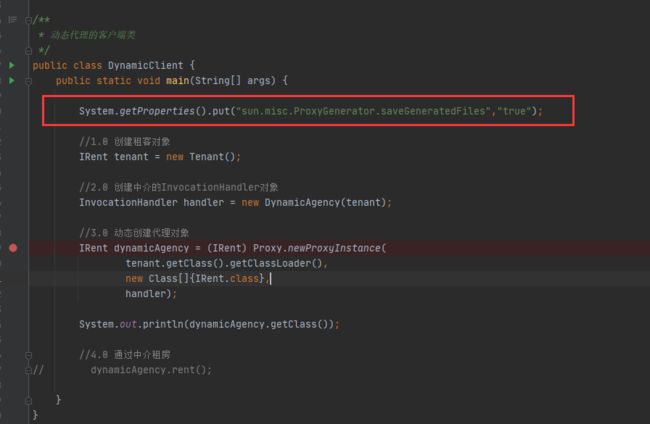
修改后再次执行代码,可以看到,在我们的项目中产生的对应的Proxy的class对象。
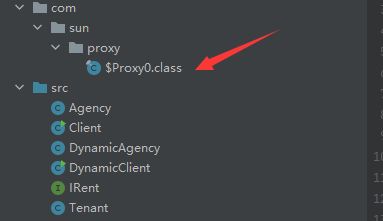
#八:真实面目
package com.sun.proxy;
import java.lang.reflect.InvocationHandler;
import java.lang.reflect.Method;
import java.lang.reflect.Proxy;
import java.lang.reflect.UndeclaredThrowableException;
public final class $Proxy0 extends Proxy implements IRent {
private static Method m1;
private static Method m3;
private static Method m2;
private static Method m0;
public $Proxy0(InvocationHandler var1) throws {
super(var1);
}
public final boolean equals(Object var1) throws {
try {
return (Boolean)super.h.invoke(this, m1, new Object[]{var1});
} catch (RuntimeException | Error var3) {
throw var3;
} catch (Throwable var4) {
throw new UndeclaredThrowableException(var4);
}
}
public final void rent() throws {
try {
super.h.invoke(this, m3, (Object[])null);
} catch (RuntimeException | Error var2) {
throw var2;
} catch (Throwable var3) {
throw new UndeclaredThrowableException(var3);
}
}
public final String toString() throws {
try {
return (String)super.h.invoke(this, m2, (Object[])null);
} catch (RuntimeException | Error var2) {
throw var2;
} catch (Throwable var3) {
throw new UndeclaredThrowableException(var3);
}
}
public final int hashCode() throws {
try {
return (Integer)super.h.invoke(this, m0, (Object[])null);
} catch (RuntimeException | Error var2) {
throw var2;
} catch (Throwable var3) {
throw new UndeclaredThrowableException(var3);
}
}
static {
try {
m1 = Class.forName("java.lang.Object").getMethod("equals", Class.forName("java.lang.Object"));
m3 = Class.forName("IRent").getMethod("rent");
m2 = Class.forName("java.lang.Object").getMethod("toString");
m0 = Class.forName("java.lang.Object").getMethod("hashCode");
} catch (NoSuchMethodException var2) {
throw new NoSuchMethodError(var2.getMessage());
} catch (ClassNotFoundException var3) {
throw new NoClassDefFoundError(var3.getMessage());
}
}
}
看到动态代理产生的$Proxy0.class之后是不是豁然开朗。
1.该代理类中,首先会继承Proxy类,并实现我们接口数组传入的接口对象。(接口数组里面有几个接口,默认就会实现几个。)
2.该代理类中,构造函数会接收我们传入的InvocationHandler对象。
3.该代理类中,会重写Object的,equals,toString,hashCode3个方法,并实现我们接口中的所有方法。
4.在静态代码块中,会去加载相同的Method对象。
5.最后,当我们调用代理对象的相应方法的时候,就会通过保存的InvocationHandler对象回调出去,并将该方法对应的代理类,Method和参数传给InvocationHandler对象。
我们来画一个调用流程图,即可以更好的帮助大家理解。以IRent接口的 rent() 方法为例。
#如果有理解错误的,麻烦告知修改,谢谢。

